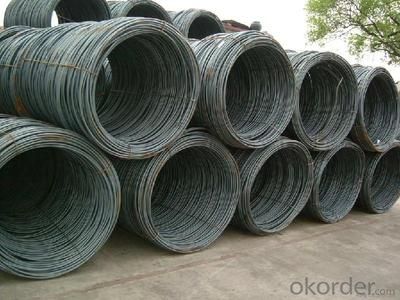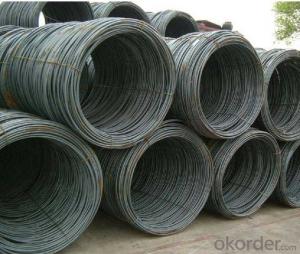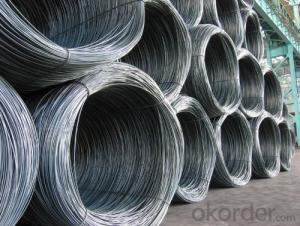Hot Rolled Carbon Steel Wire Rod 6.5mm with High Quality
- Loading Port:
- China Main Port
- Payment Terms:
- TT or LC
- Min Order Qty:
- 20 m.t.
- Supply Capability:
- 20000 m.t./month
OKorder Service Pledge
OKorder Financial Service
You Might Also Like
Product Description:
OKorder is offering Hot Rolled Carbon Steel Wire Rod 6.5mm with High Quality at great prices with worldwide shipping. Our supplier is a world-class manufacturer of steel, with our products utilized the world over. OKorder annually supplies products to European, North American and Asian markets. We provide quotations within 24 hours of receiving an inquiry and guarantee competitive prices.
Product Applications:
Hot Rolled Carbon Steel Wire Rod 6.5mm with High Quality is widely used in construction and manufacturing. Carbon steel wire rod is mainly used for reinforcement of reinforced concrete and welded structure or reprocessed (roberts , nail, etc.) materials, especially used to produce wire drawing, welding electrode, nails, spring, electronic, precise machinery parts and so on.
Product Advantages:
OKorder's Hot Rolled Carbon Steel Wire Rod 6.5mm with High Quality are durable, strong.packed and suitable for wire mesh,nail manufacture and construction
Main Product Features:
· Premium quality
· Prompt delivery & seaworthy packing (30 days after receiving deposit)
· Can be recycled and reused
· Mill test certification
· Professional Service
· Competitive pricing
Product Specifications:
Manufacture: Hot rolled
Grade: SAE1006 SAE1008 SAE1010 SAE1012 SAE1016 SAE1018
Certificates: ISO, SGS, BV, CIQ
Weight per Coil:2-2.05tons
Packaging: Export packing, packed by coil
FAQ:
Q1: Why buy Materials & Equipment from OKorder.com?
A1: All products offered byOKorder.com are carefully selected from China's most reliable manufacturing enterprises. Through its ISO certifications, OKorder.com adheres to the highest standards and a commitment to supply chain safety and customer satisfaction.
Q2: How do we guarantee the quality of our products?
A2: We have established an advanced quality management system which conducts strict quality tests at every step, from raw materials to the final product. At the same time, we provide extensive follow-up service assurances as required.
Q3: How soon can we receive the product after purchase?
A3: Within three days of placing an order, we will begin production. The specific shipping date is dependent upon international and government factors, but is typically 7 to 10 workdays.
Q4: How many tons can be loaded into one 20ft container?
A4: Around 18—20tons
Q5: What is the chemical composition and physical properties of SAE1008?
A5:
Grade | Chemical Composition (%) | |||||
C | Mn | S | P | Si | B | |
SAE1008B | 0.10max | 0.32max | 0.045max | 0.040max | 0.30max | 0.0008min |
Mechanical properties | ||||||
Yield strength(N/mm2) | Tensile strength(N/mm2) | Elongation (%) | ||||
≥195 | 350-380 | ≥32 | ||||
Images:


- Q:What are the environmental benefits of recycling steel wire rod?
- There are several environmental benefits of recycling steel wire rod. Firstly, recycling steel wire rod helps conserve natural resources by reducing the need for mining and extracting raw materials. This reduces the environmental impact associated with mining activities, such as deforestation and habitat destruction. Secondly, recycling steel wire rod reduces energy consumption and greenhouse gas emissions. Producing steel from recycled materials requires significantly less energy compared to producing steel from virgin ore. This helps mitigate climate change by reducing carbon dioxide emissions and other pollutants associated with steel production. Additionally, recycling steel wire rod helps in reducing waste in landfills. By diverting steel wire rod from disposal sites, valuable landfill space is conserved, and the potential for soil and water contamination from landfill leachate is minimized. Overall, recycling steel wire rod contributes to a more sustainable and environmentally friendly approach to steel production, conserving resources, reducing energy consumption, and minimizing waste.
- Q:What are the different surface finishes of steel wire rod available?
- There are several different surface finishes available for steel wire rod, including black, pickled and oiled, galvanized, and coated.
- Q:What are the common industry research initiatives for steel wire rod?
- Some common industry research initiatives for steel wire rod include exploring new production techniques and technologies to improve the quality and efficiency of manufacturing processes, conducting market analysis to identify emerging trends and demands, investigating the impact of different alloys and coatings on the wire rod's performance, and studying the potential for utilizing recycled materials in wire rod production to enhance sustainability. Additionally, research efforts may focus on optimizing wire rod specifications to meet the evolving requirements of various end-users, such as the automotive, construction, and manufacturing sectors.
- Q:What are the main factors influencing the choice of steel wire rod manufacturer?
- There are several main factors that influence the choice of a steel wire rod manufacturer. These factors include: 1. Quality of the product: One of the primary factors influencing the choice of a steel wire rod manufacturer is the quality of the product they offer. Customers look for manufacturers that produce high-quality steel wire rods that meet their specific requirements and standards. This includes factors such as the strength, durability, and consistency of the wire rod. 2. Price: Price is another crucial factor that influences the choice of a steel wire rod manufacturer. Customers compare prices offered by different manufacturers and choose the one that provides the best value for money. However, it is important to consider the price in relation to the quality of the product and the overall service provided by the manufacturer. 3. Reliability and reputation: The reliability and reputation of a steel wire rod manufacturer play a significant role in the decision-making process. Customers prefer manufacturers with a proven track record of delivering high-quality products consistently and on time. Positive customer reviews, testimonials, and references from other trusted sources can greatly influence the choice of a manufacturer. 4. Production capacity and capabilities: The production capacity and capabilities of a steel wire rod manufacturer are important considerations for customers. Depending on their specific needs, customers may require a manufacturer that can produce large quantities of wire rods within a specified timeframe. Additionally, customers may also consider the manufacturer's ability to provide customized wire rod solutions or different variations of the product. 5. Technical expertise and support: Steel wire rod manufacturers with strong technical expertise and excellent customer support are often preferred by customers. Manufacturers that can provide technical guidance, assistance with product development, and after-sales support are seen as valuable partners in the steel wire rod purchasing process. 6. Environmental and sustainability practices: In recent years, environmental and sustainability practices have become increasingly important factors in the choice of a steel wire rod manufacturer. Customers look for manufacturers that prioritize sustainable production methods, minimize waste and emissions, and comply with environmental regulations. Overall, the main factors influencing the choice of a steel wire rod manufacturer are quality, price, reliability, production capacity, technical expertise, and environmental practices. Customers carefully evaluate these factors to ensure they select a manufacturer that can meet their specific requirements and provide a high-quality product and service.
- Q:What are the different types of steel wire rod surface treatments?
- The different types of steel wire rod surface treatments include galvanizing, coating, passivating, and pickling.
- Q:What are the main applications of steel wire rod in automotive manufacturing?
- Steel wire rod is widely used in automotive manufacturing due to its strong and durable properties. Some of the main applications of steel wire rod in this industry include: 1. Suspension systems: Steel wire rod is commonly used in the manufacturing of suspension systems, such as coil springs and torsion bars. These components play a crucial role in maintaining the stability and smoothness of the vehicle's ride, and the strength of steel wire rod enables them to withstand heavy loads and provide reliable performance. 2. Seat frames: Steel wire rod is often used to construct the frames of automotive seats. The high tensile strength of steel wire rod ensures that the seats can support the weight of passengers and withstand the constant stress and strain during use. 3. Wire harnesses: Steel wire rod is used to manufacture wire harnesses, which are essential in the electrical systems of vehicles. These wire harnesses provide a reliable and organized way to route and secure electrical wires, ensuring proper functioning of various electrical components such as lights, sensors, and control systems. 4. Safety components: Steel wire rod is also utilized in the production of various safety components in vehicles. For example, it is commonly used in the manufacturing of seatbelt systems, where the high strength of steel wire rod ensures the seatbelt's ability to restrain passengers during accidents. 5. Engine components: Steel wire rod is used in the manufacturing of engine components, such as valve springs and piston rings. These components require high strength and durability to withstand the extreme conditions and constant movement within the engine. Overall, steel wire rod plays a critical role in automotive manufacturing, contributing to the strength, safety, and performance of vehicles. Its versatility and ability to withstand heavy loads and stress make it an ideal material for various applications in this industry.
- Q:What are the main challenges in manufacturing steel wire rod?
- There are several main challenges in manufacturing steel wire rod. One of the challenges is ensuring consistent quality and uniformity in the wire rod production. This involves maintaining precise control over the chemical composition and mechanical properties of the steel, as any deviation can affect the performance and reliability of the final product. It requires strict adherence to quality control procedures and continuous monitoring throughout the manufacturing process. Another challenge is achieving the desired dimensional accuracy and surface finish of the wire rod. This involves controlling the temperature and speed during the rolling process to ensure proper shape and size. Any irregularities or defects in the wire rod can affect its strength and durability, making it unsuitable for its intended applications. Maintaining a high production rate while ensuring safety and minimizing downtime is also a significant challenge. Steel wire rod manufacturing typically involves complex machinery and equipment, which require regular maintenance and monitoring to prevent breakdowns. Additionally, ensuring worker safety in such an environment requires implementing strict safety protocols and providing appropriate safety equipment. Environmental sustainability is another challenge in manufacturing steel wire rod. The production process involves high energy consumption and emissions of greenhouse gases. Reducing the environmental impact requires implementing energy-efficient technologies, recycling and reusing waste materials, and adopting sustainable practices throughout the entire production chain. Furthermore, the steel wire rod industry faces the challenge of increasing competition and fluctuating market demands. Manufacturers need to stay updated with the latest market trends, adapt to changing customer requirements, and constantly innovate to remain competitive. This includes investing in research and development to improve product quality, develop new alloys, and explore alternative manufacturing methods. Overall, manufacturing steel wire rod requires addressing challenges related to quality control, dimensional accuracy, safety, environmental sustainability, and market competitiveness. Overcoming these challenges requires a combination of advanced technology, skilled workforce, and continuous improvement in manufacturing processes.
- Q:How is steel wire rod used in the manufacturing of wire containers?
- Steel wire rod is a crucial component in the manufacturing of wire containers. Wire containers are widely used in various industries such as logistics, warehousing, and transportation for their durability, strength, and versatility. Steel wire rod is first transformed into wire through a series of processes, including drawing, annealing, and coating. The wire is then shaped and welded into the desired container design, whether it is a basket, cage, or pallet. The high tensile strength of steel wire rod ensures that the wire containers can withstand heavy loads and resist deformation, making them suitable for storing and transporting various goods. Moreover, the durability of steel wire rod enables the wire containers to withstand harsh environments, including extreme temperatures and corrosive substances. The flexibility of steel wire rod also allows for the customization of wire containers. Manufacturers can easily adjust the diameter, length, and thickness of the wire to meet specific requirements. This flexibility enables the production of wire containers in different sizes and designs, ensuring they can accommodate a wide range of products and fit into various storage systems. In addition to their strength and durability, wire containers made from steel wire rod are also lightweight, making them easier to handle and transport. This feature is especially beneficial in industries where frequent loading and unloading of goods are required. Overall, steel wire rod plays a vital role in the manufacturing of wire containers by providing the necessary strength, durability, and flexibility. Its usage ensures the production of reliable and efficient storage and transportation solutions for various industries.
- Q:What are the different types of defects that can occur in steel wire rod?
- Steel wire rods can have various defects, which can arise from manufacturing or external factors. Examples of defects include surface, internal, and dimensional defects. Surface defects, such as scratches, pits, cracks, and scale, are easily visible and can occur due to mishandling, improper storage, or issues during rolling or finishing processes. These defects can affect the appearance and functionality of the wire rods, often requiring additional processing or treatment for correction. Internal defects, which are not visible from the surface, can weaken the wire rod and reduce its mechanical properties. Inclusions are foreign particles trapped within the steel matrix during manufacturing, voids are areas lacking material, and segregations refer to variations in composition or structure. These defects make the wire rod more susceptible to failure under stress or load. Dimensional defects refer to variations or deviations from specified dimensions and tolerances. These defects can include differences in diameter, out-of-roundness, straightness, or surface finish. Issues with the rolling process, cooling or heat treatment, or variations in raw materials can cause these defects. They can affect the suitability and performance of the wire rod for its intended use. To minimize defects, it is crucial to follow proper manufacturing practices, implement quality control measures, and adhere to industry standards and specifications. Regular inspection and testing of wire rods can help detect and rectify any defects, ensuring the production of high-quality and dependable steel wire rods.
- Q:What are the common applications of pre-stressed and oil tempered steel wire rod?
- Pre-stressed steel wire rod is commonly used in construction and engineering applications, such as for pre-tensioning or post-tensioning of concrete structures, bridges, and high-rise buildings. It helps to improve the load-bearing capacity, durability, and overall structural integrity of these projects. On the other hand, oil tempered steel wire rod is frequently utilized in the manufacturing of springs, suspension systems, and other high-stress applications. Its unique properties, obtained through the tempering process, provide excellent resistance to fatigue and ensure reliable performance in demanding industries such as automotive, aerospace, and machinery.
1. Manufacturer Overview |
|
|---|---|
| Location | |
| Year Established | |
| Annual Output Value | |
| Main Markets | |
| Company Certifications | |
2. Manufacturer Certificates |
|
|---|---|
| a) Certification Name | |
| Range | |
| Reference | |
| Validity Period | |
3. Manufacturer Capability |
|
|---|---|
| a)Trade Capacity | |
| Nearest Port | |
| Export Percentage | |
| No.of Employees in Trade Department | |
| Language Spoken: | |
| b)Factory Information | |
| Factory Size: | |
| No. of Production Lines | |
| Contract Manufacturing | |
| Product Price Range | |
Send your message to us
Hot Rolled Carbon Steel Wire Rod 6.5mm with High Quality
- Loading Port:
- China Main Port
- Payment Terms:
- TT or LC
- Min Order Qty:
- 20 m.t.
- Supply Capability:
- 20000 m.t./month
OKorder Service Pledge
OKorder Financial Service
Similar products
New products
Hot products
Related keywords




























